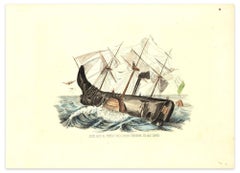Plant Sta
1840s Figurative Prints
Lithograph
Antonio Masutti for sale on 1stDibs
Antonio Masutti was an Italian painter, draftsman, engraver, lithographer, illustrator, and caricaturist. From a poor and numerous family, Masutti managed to redeem himself: his talent was discovered almost by chance and confirmed by several prizes that he won between 1830 and 1834. From 1839, he worked at the Kier printing plant. Masutti made the illustrations for the Strenna Triestina for the editions of 1839–40. He moved to Rome, first to continue his academic career, then changed his mind, entering the group of engravers and illustrators that revolved around the figure of the intellectual and patriot Michelangelo Pinto. For the latter, he made the drawings for the satirical newspaper Il Don Pirlone, of which 106 are now preserved at the British Museum in London. Masutti knows the Piedmontese group: the engraver Enrico Parmiani who puts him in contact with Agostino Lauro. Following Pinto, he moved to Turin in 1849. He continued to work for Pinto at Il Don Pirlone in Rome. Starting from 1851, he illustrated the Pantheon of the martyrs of Italian freedom. For the Turin bourgeoisie, he began to create miniature portraits for which he received good feedback. In 1856, Masutti illustrated the New Mysteries of Contemporary Rome, one of his most important illustrative works. He established a close relationship with Cavour, of whom he made many portraits. Between 1860–63, Masutti illustrated the History of Italy by Giuseppe La Farina and the five volumes of Pietro Corelli La Stella d'Italia or Nove Secoli di Casa Savoia. He came into contact with the major Risorgimento writers for whom he worked as an illustrator, in addition to Prati, also Francesco Domenico Guerrazzi and Antonio Ranieri. Masutti’s portrait of King Vittorio Emanuele II, engraved by Agostino Lauro, got him national resonance. Vittorio Emanuele II gave him the title of knight.
Finding the Right figurative-prints-works-on-paper for You
Bring energy and an array of welcome colors and textures into your space by decorating with figurative fine-art prints and works on paper.
Figurative art stands in contrast to abstract art, which is more expressive than representational. The oldest-known work of figurative art is a figurative painting — specifically, a rock painting of an animal made over 40,000 years ago in Borneo. This remnant of a remote past has long faded, but its depiction of a cattle-like creature in elegant ocher markings endures.
Since then, figurative art has evolved significantly as it continues to represent the world, including a breadth of works on paper, including printmaking. This includes woodcuts, which are a type of relief print with perennial popularity among collectors. The artist carves into a block and applies ink to the raised surface, which is then pressed onto paper. There are also planographic prints, which use metal plates, stones or other flat surfaces as their base. The artist will often draw on the surface with grease crayon and then apply ink to those markings. Lithographs are a common version of planographic prints.
Figurative art printmaking was especially popular during the height of the Pop art movement, and this kind of work can be seen in artist Andy Warhol’s extensive use of photographic silkscreen printing. Everyday objects, logos and scenes were given a unique twist, whether in the style of a comic strip or in the use of neon colors.
Explore an impressive collection of figurative art prints for sale on 1stDibs and read about how to arrange your wall art.
